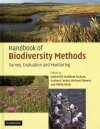About this book
Please note (January 2014): the publisher has announced that the paperback version of this book has been cancelled.
A key reference, compiled by conservation practitioners (Hill, Fasham and Tucker are environmental consultants, Shewry and Shaw are at Scottish Natural Heritage, the governmental nature conservation agency for Scotland).
Biodiversity is recognised to be of global importance, yet species and habitats continue to be under increasing pressure from human-induced influences. Environmental concerns are high on the political agenda, driving increased legislation to protect the natural environment. The starting point for much of this legislation is the requirement for a comprehensive biodiversity audit. For those needing to undertake such audits, this Handbook provides standard procedures which will enable practitioners to better monitor the condition of the biodiversity resource, resulting in improved data upon which to base future policy decisions and actions. Organised in three parts, the Handbook first addresses planning, covering method selection, experimental design, sampling strategy, and data analysis and evaluation. The second part describes survey, evaluation and monitoring methods for a broad range of habitats. Part three considers species and provides information on general methods before addressing specific methods of survey and monitoring for the major taxonomic groups.
Contents
Preface
Acknowledgements
Part I. Planning M. Fasham, G. Tucker, A. Bennett, T. Rich, M. Shewry, P. Shaw and M. Wade
1. Introduction to Part 1
2. Planning a programme
3. Evaluation methods
Part II. Habitats G. Tucker, M. Fasham, T. Rich, M. Rebane, G. Peterken, F. McMeechan and R. Birnie
4. Introduction to Part 2
5. Habitat requirements and issues
6. Methods for surveying habitats
7. Surveying and monitoring management or environmental impacts
8. Habitat conservation evaluation criteria
Part III. Species
9. Introduction to Part 3
10. General principles and methods for species M. Fasham and S. Mustoe
11. Fungi R. Watling, M. Fasham and D. Dobson
12. Lichens S. Davey, M. Fasham and D. Dobson
13. Bryophytes G. Rothero, D. Dobson and M. Fasham
14. Aquatic macrophytes and algae N. Stewart and M. Wade
15. Vascular plants T. Rich, V. Hack and F. McMeechan
16. Dragonflies and damselflies C. Plant, R. Sands, M. Fasham
17. Butterflies C. Plant, R. Sands and M. Fasham
18. Macromoths C. Plant, R. Sands and M. Fasham
19. Other terrestrial invertebrates P. Dennis, C. Plant, R. Sands and M. Fasham
20. Aquatic invertebrates P. Kerrison, T. Norman, M. Fasham
21. Fish N. Giles, R. Sands and M. Fasham
22. Amphibians D. Latham, E. Jones, M. Fasham
23. Reptiles D. Latham, E. Jones, M. Fasham
24. Birds S. Mustoe, D. Hill, D. Frost, G. Tucker
25. Bats R. Stebbings, H. Mansfield and M. Fasham
26. Other mammals A. Bennett, P. Ratcliffe, E Jones, H. Mansfield and R. Sands
Acknowledgements
Glossary
Appendices
Recommended sources of further information
References
Index
Customer Reviews
Biography
David Hill is Director of Ecology, RPS Group plc, UK. Matthew Fasham is Principal Consultant, RPS Group plc, UK. Graham Tucker is a freelance ecological consultant with Ecological Solutions, UK. Michael Shewry is Environmental Statistician, Scottish Natural Heritage, UK. Philp Shaw is Environmental Audit Officer, Scottish Natural Heritage, UK.



































